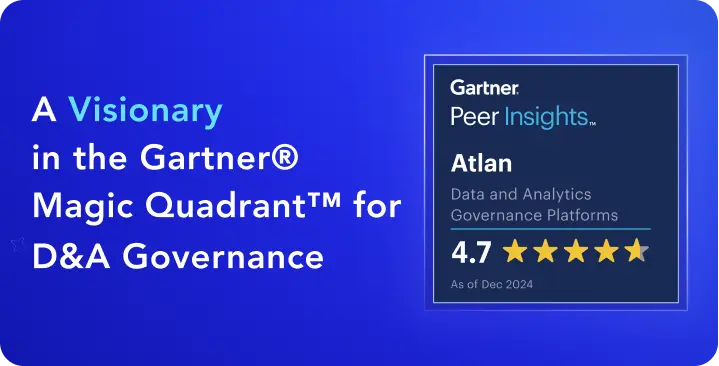Data Governance in Manufacturing: Challenges, Business Benefits, Essential Capabilities
Share this article
Data governance in manufacturing ensures the effective use of data, enabling manufacturers to make informed decisions, optimize operations, and comply with industry regulations.
See How Atlan Simplifies Data Governance – Start Product Tour
This article explores how data governance unlocks business value, addresses common challenges in manufacturing, and highlights key capabilities to look for in an enterprise data governance solution.
Table of contents #
- What is data governance in manufacturing?
- The need for data governance in manufacturing
- Key challenges
- What business outcomes can manufacturing achieve through data governance?
- What are the essential capabilities needed for effective data governance in manufacturing?
- Data governance in manufacturing ensures compliance and drives efficiency
- Related reads
What is data governance in manufacturing? #
Data governance in manufacturing is an approach to manage data throughout the production lifecycle and ensure its accuracy, consistency, and security.
It goes beyond organizing data—it integrates policies and standards into all aspects of manufacturing, from quality control and supply chain management to regulatory compliance and innovation.
The need for data governance in manufacturing #
As manufacturing processes become increasingly data-driven, effective data governance is essential to consistently manage, classify and tag various data types and formats. Examples of data types in manufacturing include:
- Product lifecycle data: Design specifications, engineering change orders, bill of materials (BOM), production timelines, end-of-life product management
- Operational data: Machine performance metrics, downtime statistics, production schedules, equipment maintenance logs, sensor data
- Supply chain data: Supplier information, material availability, lead times, delivery schedules, inventory levels, procurement costs
- Quality data: Product specifications, defect rates, inspection results, quality assurance test outcomes, warranty claims
- Customer data: Order histories, customer feedback, demand forecasts, service requests, complaint resolutions
- Environmental data: Emissions levels, waste output, water usage, recycling rates, compliance with environmental regulations like the EPA or RoHS
- Compliance data: Audit trails, certification records (ISO, FDA), safety incident reports, records of regulatory inspections and compliance status
Managing all these data formats in manufacturing requires accurate classification and tagging to streamline processes like data search, discovery, and tracking.
Without proper data governance, manufacturers struggle to make sense of diverse data streams, leading to inefficiencies, poor decision-making, and compliance risks. Let’s explore four key challenges manufacturers face.
Data governance in manufacturing: 4 key challenges #
Without effective data governance, manufacturers face issues such as:
- Data silos
- Data inconsistencies
- Compliance and regulatory challenges
- Scalability issues
Let’s explore the specifics.
1. Data silos #
Disjointed systems across production, logistics, and quality control create data silos, making it hard to get a unified view of operations.
A survey of 1,022 individual contributors and C-suite collaboration decision-makers from the US and the UK reveals the widespread challenge of data silos across industries. On average, these professionals spend 30% of their workweek—about 2.4 hours each day—simply searching for the right data and information.
2. Data inconsistencies #
Poor data quality results in inaccurate metrics, leading to operational risks. Organizations lose an average of $12.9 million annually due to poor data quality, according to a study by Gartner in 2021.
For manufacturers, incorrect machine performance metrics or inventory levels can result in overproduction, defects, or delayed shipments.
3. Compliance and regulatory challenges #
Compliance regulations such as ISO and environmental standards require manufacturers to track vast amounts of data. Failure to comply can lead to product recalls or fines.
In March 2024, the FAA identified compliance issues during an audit of Boeing’s 737 MAX production processes, leading to increased oversight and demands for corrective actions. While no fines have been imposed yet, unresolved issues could result in significant penalties, according to Reuters.
Also, read → Why data governance and compliance is an act of checks and balances
4. Scalability issues #
As manufacturing scales, data from machinery, supply chains, and customer feedback multiplies, often overwhelming systems not equipped to handle large volumes.
A 2021 survey conducted by the World Economic Forum in collaboration with Boston Consulting Group found that only 39% of companies could scale data-driven projects beyond a single value stream, such as the production process of one product. This highlights scalability as a critical challenge.
What business outcomes can manufacturing achieve through data governance? #
Effective data governance simplifies compliance and offers several business benefits. Let’s see its impact on the following business outcomes:
- Avoid fines and improve audit readiness to comply with regulations
- Protect intellectual property and reduce breach risks
- Eliminate silos and reduce manual processes to improve operational efficiency
- Gain real-time insights, enhance visibility, and improve decision-making
Now, let’s delve into the details of each benefit.
1. Avoid fines and improve audit readiness to comply with regulations #
Data governance ensures manufacturers meet regulations by maintaining accurate, up-to-date records across production and supply chains. With traceable, audit-ready data, companies reduce legal risks, improve accountability, and streamline compliance reporting—freeing them to focus on innovation.
For example, a pharmaceutical company can implement a data governance program to manage clinical trial data, ensuring it’s accurate and secure. This speeds up regulatory approvals and accelerates the time-to-market for new drugs, benefiting both the company and patients.
2. Protect intellectual property and reduce breach risks #
Data breaches pose a significant risk to manufacturers, particularly when it comes to protecting intellectual property and sensitive supply chain information.
Effective data governance involves establishing strong security measures, access controls, and privacy policies. As a result, you can better protect sensitive data, such as intellectual property and customer information.
For example, Aliaxis, a global water solutions manufacturer, needed to improve data security and mitigate risks around sensitive information (like IP data). To address this, they leveraged Atlan’s modern data catalog. This helped in enhancing data security through better visibility and automated data lineage, while reducing the risk of unauthorized access and cyber threats.
3. Eliminate silos and reduce manual processes to improve operational efficiency #
By breaking down data silos, automating workflows, and creating a single source of truth, data governance can eliminate data silos, reduce manual tasks, improve collaboration, and drive operational efficiency.
For example, data owners at Aliaxis would maintain spreadsheets to track data sources and transformations. By automating documentation processes with Atlan, Aliaxis saved significant time and resources. This led to a 95% reduction in time spent on manual data management tasks, thereby reducing costs and increasing productivity.
4. Gain real-time insights, enhance visibility, and improve decision-making #
With data governance, manufacturers can get real-time visibility across their operations and supply chains. As a result, manufacturers can improve forecasting, inventory management, and production schedules.
At Aliaxis, the rapid expansion of their data platform resulted in a growing number of inquiries from data consumers regarding the availability of data and its meaning. This led to engineering bottlenecks and slowed down decision-making.
So, Aliaxis used Atlan to set up a unified business glossary that improved data access and understanding for over 15,000 employees across 40 countries, allowing for faster decision-making and better utilization of data assets.
Integrating Atlan with their existing data stack (Snowflake, Power BI) also helped employees find and understand the data they needed without requiring any technical assistance.
What are the essential capabilities needed for effective data governance in manufacturing? #
Effective data governance in manufacturing requires the right set of capabilities, as outlined in the latest Forrester Wave™ report for enterprise data catalogs. These include (but aren’t limited to):
1. Data governance, risk, and compliance
- Frameworks for managing compliance with industry standards and regulations ( ISO, FDA)
- Risk management tools for data integrity and security
2. Metadata management
- Automated metadata extraction, cataloging, updates, and sync
- Standardized metadata tagging and classification
3. Data cataloging
- An enterprise data catalog with cross-platform semantic mapping acts as a single source of truth for all types and formats of data
- Natural language search and data discovery powered by metadata filters
4. Data lineage and traceability
- Automated, actionable, granular data lineage mapping tracking data flow
- Support for impact and root-cause analysis
5. Data access and security
- Granular access control and security measures
- Secure and simple data-sharing mechanisms within and outside the organization
- Audit trails and reporting
6. AI-driven insights and process automation
- AI-assisted data governance policy creation, documentation, and management
- Automated workflows for data asset documentation, tagging, compliance, reporting, etc.
7. Data quality
- Continuous data quality monitoring
- Automated data cleansing and validation
8. Integration and collaboration capabilities
- Seamless integration with existing systems and technologies (ERP, MES, and IoT devices)
- Collaboration features for cross-team communication
9. Ease of deployment
- Support for various deployment environments (on-premise, cloud, multi-cloud) to align with organizational infrastructure
- Rapid adoption mechanisms
These capabilities create a solid foundation for successful data governance in manufacturing, driving efficiency and enabling innovation.
Bottom line: Data governance in manufacturing ensures compliance and drives efficiency #
Data governance in manufacturing helps streamline processes, ensure compliance, and unlock data-driven insights that can cut costs while driving productivity and operational efficiency.
With the right governance practices, manufacturers can not only mitigate risks but also position themselves for innovation and continued growth.
Data governance in manufacturing: Related reads #
- What is Data Governance? Its Importance, Principles & How to Get Started?
- Automated Data Governance: How Does It Help You Manage Access, Security & More at Scale?
- Data Governance Strategy: How To Get Started?
- Data Governance Key Components: What to Know in 2024
- Data Governance Tools: Capabilities, Trends & Deployment
- Data Catalog and Data Governance: How Do They Complement?
- Key Objectives of Data Governance: How Should You Think About Them?
- Data Governance Framework — Examples, Templates, Standards, Best Practices & How to Create One?
- Data Governance and Compliance: Act of Checks & Balances
- How to implement data governance? Steps, Prerequisites, Essential Factors & Business Case
- How to Improve Data Governance? Steps, Tips & Template
- 7 Steps to Simplify Data Governance for Your Entire Organization
Share this article











